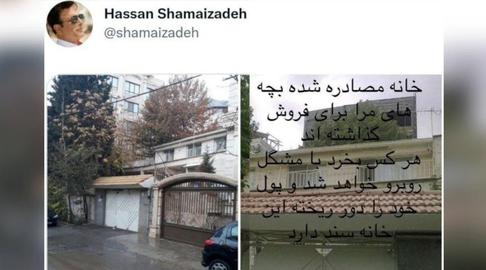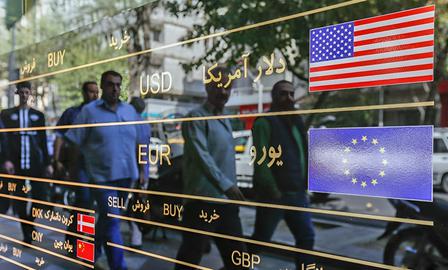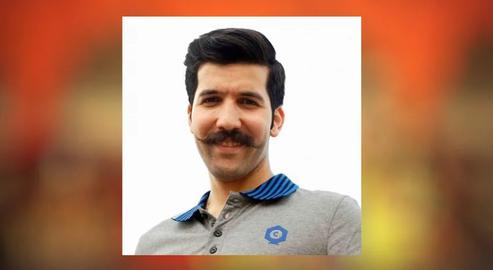Famous Iranian pop singer Hassan Shamaizadeh, who emigrated to the United States after the Islamic Revolution, has sounded the alarm over his family’s property being appropriated by the regime. In an Instagram post, Shamaizadeh said his children’s house, which had been confiscated by the Revolutionary Court due to his profession, had been newly placed on the open market. He issued a public plea for people not to buy it.
Shamaizadeh is one of hundreds of Iranian musicians and filmmakers, as well as ex-officials, military men and merchants of the Pahlavi era and members of the Shah’s own family whose assets were seized after the 1979 Islamic Revolution. The below is a brief history of how and why this occurred – and what the law says about it.
***
"There was one committee commander in Kerman. He was conducting an aerial search by helicopter for a smuggler in the Bam desert, when he saw a garden in an orchard in the middle of the desert. It was owned by one Abbas Khan Ameri, who had built a unique, 700-hectare grove. Mr. Marashi asked me, ‘Shall we confiscate it?’.”
So recounted Hossein Marashi, a senior member of the Kargozaran Party, of the days immediately after the 1979 revolution. The narrative perfectly illustrated the chaos of property and asset seizures under the fledgling Islamic government – acquisitions that were meant to be repurposed to support the "oppressed", which instead, but four later, have ended up under the control of Supreme Leader Ali Khamenei.
A few weeks after Ayatollah Khomeini arrived back in the country on February 28, 1979, at a time when the Constitution of the Islamic Republic still had yet to be approved, the first Supreme Leader had issued an order to confiscate the properties of all those affiliated with the Pahlavi government. "According to this letter,” the decree ran, “the Council of the Islamic Revolution has the mission to confiscate all movable and immovable property of the Pahlavi Dynasty and those branches, agents and members of the Dynasty who embezzled from the Muslim treasury during their period of illegal rule, for the benefit of the poor, the workers and the weak employees. Inform the government that the spoils acquired do not belong to the government and are under the responsibility of the Revolutionary Council. What government officials have gained or acquired should be handed over to the bank in the same number."
The Islamic Revolutionary Committees quickly set about requisitioning the assets of ex-employees of the Imperial Army, the intelligence agency SAVAK, ministers, directors, and even a large number of artists, craftsmen, and merchants whose "affiliation" with the Shah or his government was suspected. One of the directors of the University of Tehran has recently said that based on his research, he has established for certain that "none" of those merchants and craftsmen had an "organic relationship" with the Pahlavi regime.
Ayatollah Sadegh Khalkhali, the first religious judge to be appointed by Ruhollah Khomeini, who sentenced many Imperial Army officials to death and oversaw the repossession their property both before and after the Constitution’s adoption, gave a telling speech shortly after his disqualification on the eve of Iran’s fourth parliamentary elections. In it, he clearly pointed to the total unimportance of the law to confiscation efforts: "I have nothing to do with you," he said. “I was the judge of the Imam. I judged by myself, and I executed by myself, and I confiscated by myself. My appraisal was not based on a judgment... I was the ruler of the Imam's sharia."
Institutionalizing a Mass Theft
In July 1980, one year after the Constitution of the Islamic Republic had been adopted, the Foundation of the Oppressed of the Islamic Revolution (Bonyad-e Mostazafan) took over the task of acquiring "the assets of the Pahlavi dynasty and all those who depended on them". Based on an order by Khomeini the previous March, Article 49 of the Constitution gave the confiscations a legal underpinning. It stated: "All wealth gathered from usury, usurpation, bribery, embezzlement, theft, gambling, the misuse of endowments, the abuse of government contracts and transactions, the sale of barren land, the establishment of places of corruption and other illegitimate matters, should be collected by the government and given back to the owners. If the owner is not known it should be deposited in the treasury."
Under what circumstances was Article 49 approved by the new Iranian parliament? Abdol Karim Lahiji, a veteran human rights activist and one of the jurists who wrote the first draft of the Constitution for the post-Shah government, told IranWire about the clergy 's absolute domination over the Assembly of Experts: "Almost three quarters of the Assembly of Experts then were clerics, and the only thing they knew was jurisprudence, not law. At the same time, on the very first day the Assembly sat, Mr. Khomeini gave the message that since this Constitution was being prepared for the Islamic Republic, only the representatives of the jurisprudent or, as he puts it, “experts” should comment on it.”
As such, Lahiji said, an original draft of the Constitution that had a greater focus on human rights was lost. Instead, “another set of rules based on the Islamic law and Velayat-e Faqih [Guardianship of the Islamic Jurist] was put on the agenda. Under this ideology, one of the basic principles was ‘insider’ versus ‘outsider’. Anyone who accepted the system with all its requirements was an insider; anyone who criticized it an outsider. Article 49 is the product of such thinking. They sought to take the property of anyone both ideologically and politically critical [of the new regime], in the name of ‘the oppressed’. By mentioning all the various types of illicit property, it leaves the judge's hand open in law to issue a confiscation order in any case he personally finds to be illegal."
From that point on, the judiciary was able to arbitrarily seize the properties of any artists, businesspeople, factory owners, religious minorities and, of course, political opponents that took its fancy. The theft of Hassan Shamaizadeh’s family home in Tehran is a case in point. In an interview with Iran International, Shamaizadeh has said the house was originally his wife's inheritance, and later transferred to his son.
Shamaizadeh said the court had ruled the house was "a property mixed with haram [forbidden] because my assets, as a singer, has been incorporated [into it]". In the same interview, he said the court’s decision took place without the presence of the family’s lawyer and without the family being notified. “One day when my mother left the house, and when she returned, she saw that the house had been broken into and some people were inside it. They said it had been confiscated and ‘You have no right to live in it’.”
Vagaries of Law Give Property Owners No Redress
Lawyer Musa Barzin Khalifehlou told IranWire that not only is the original rule on confiscations vague, but: “There is no provision that states these cases are handled in accordance with the criminal procedure. Many cases of property and asset confiscation, be they of religious minorities, dissidents or others, happen without going through this process first." He added: “This article of the Constitution is in sharp conflict with human rights standards and, of course, has many ambiguous elements. As such, the manner in which such cases are tried is also quite vague and it’s not clear how defendants can defend their rights in court."
Mohammad Oliaeifard, a lawyer and legal adviser to IranWire, adds: “Since the death of Ayatollah Khomeini and the coming to power of Ayatollah Khamenei, an order has been issued by the new leader, according to which the special courts’ verdict in these cases is final and irrevocable. That’s even though under another order, a panel appointed by the head of the judiciary was tasked with reviewing cases considered to be erroneous."
From the Oppressed to the Leader’s Pocket
Shortly before his death in 1989, Ayatollah Khomeini issued an order for the formation of a holdings company called Executive Headquarters of Imam's Directive, also known as Setad, to take control of the assets obtained from confiscations. This fell under the control of the Supreme Leader and was a key step in the formation of the more than $90bn financial empire Khamenei controls today.
Not only was the establishment of Setad a direct violation of the Constitution, Oliaeifard says, but even before then in 1984, the parliament had changed the provisions of Article 49 in favor of the Supreme Leader. "Instead of the government, the article now stipulates that the amounts [requisitioned] under the Article 49 be transferred to the account of the Supreme Leader.” Khomeini had previously been distributing the confiscated property to various institutions such as the Martyrs’ Foundation to compensate the families of the Iran-Iraq war dead.
Today, more than 40 years after Ayatollah Khomeini's original fatwa, foundations controlled by the Supreme Leader – which have little to nothing to do with the “oppressed” – continue to rake in massive profits from assets seized under dubious law. Recently an MP said the Iranian people would be “shocked” to learn the true wealth of the Martyrs’ Foundation alone: trustee Yahya al-Eshaq has indicated it holds at least two percent of the country’s GDP. Setad, meanwhile, is one of the biggest holdings companies in the Middle East and in Khamenei’s hands, has become a shadow entity in the governance of the Islamic Republic.
Related coverage:
Confiscation of Baha'i Properties is Illegal Even Under Iranian Law
The Tragedy of a Baha’i Hospital Confiscated by the Islamic Revolution
visit the accountability section
In this section of Iran Wire, you can contact the officials and launch your campaign for various problems





















comments